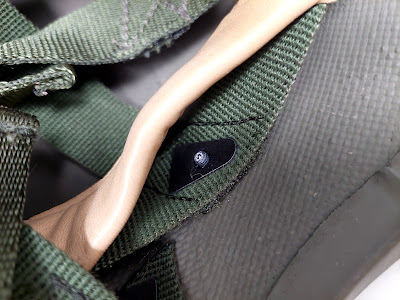Spanish beauty.
In my opinion, the Spanish Marte II is one of the most attractive helmets ever made.
Introduced in the mid-1980s, the Marte family of helmets represents Spain's first truly-modern combat helmet.
The shell is a combination of Aramid resin and Kevlar.
This helmet is an indicator that post-Franco Spain was moving away from it's unfortunate association with the trappings of WWII Germany, Franco's good pal Hitler, and the steel M.42-style "Z-helmet" which proceeded the Marte family of helmets.
In 1977 Spain held its first free-election in decades and many historians view that election as Spain's entry into the modern world. With that era came the modernization of the Spanish military, and a new ballistic combat helmet.
One could argue that the profile retains the Germanic influence, but this is true for nearly all composite helmets from the last decades of 20th century to today.
The helmet comes in sizes small, medium, and large, with the medium-sized helmet coming in at just over 2.5 pounds.
Spain was the first country in Europe to adopt the modern composite-type helmet that is nearly universal today.
If I am reading him right, Joseba Reuvelta claims that this helmet provides the highest level of protection (level 5). I'd like to look in to that a little more.
A flaw of this otherwise well-designed helmet, and it is a pretty significant flaw, are all of the through-holes drilled into the shell to accommodate mounting furniture for the suspension and chinstrap. Each of these holes presents a serious weak-point for the helmet.
On this unissued helmet, the rough, anti-reflective surface is very evident; as is the edging on the rim.
The hollow mounting-screws are particularly distinctive. This photo also shows the very coarse nature of the anti-reflective aggregate.
The chinstrap and suspension are of particularly high-quality, some of the best I've seen in a helmet of this era.
"Pull the dot" snaps provide closures.
Note that the chinstrap loops swivel laterally.
The suspension utilizes the tried-and-true Riddell design.
The nomenclature label includes the insignia of the Spanish Marine Corps.
All of the stitching and hardware are particularly robust.
The meaning of the hand-written inscription is unknown to me.
The washers are the second cousins of the American "A" washer, in a very modified state.
Velcro fastening allows for size adjustment of the headband.
Like nearly all helmets of the modern era, the chinstrap assembly includes "Y" yoke straps and a rudimentary chin-cup.
The woodland/leaf pattern camouflage was adopted when Spain joined NATO in 1982.
The cover has seven foliage loops for additional camouflage capability.
Now, for some action shots:
Altogether, a particularly handsome helmet, and a favorite of mine.
That's it for now. See you next time with another cool helmet from the collection.
Mannie
Pickersgill, Greg
Revuelta, Joseba. Cascos Del Siglo XX
Camopedia camopedia.org.index.php/spain
La Moncloa, History of Spain https://www.lamoncloa.gob.es/lang/en/espana/historyandculture/history/Paginas/index.aspx




































